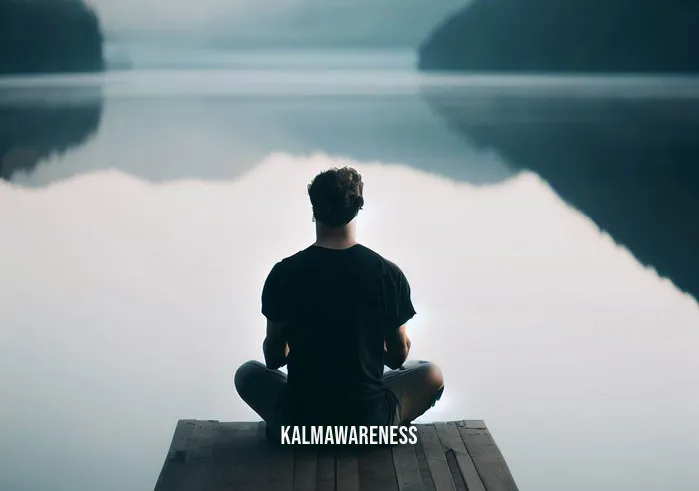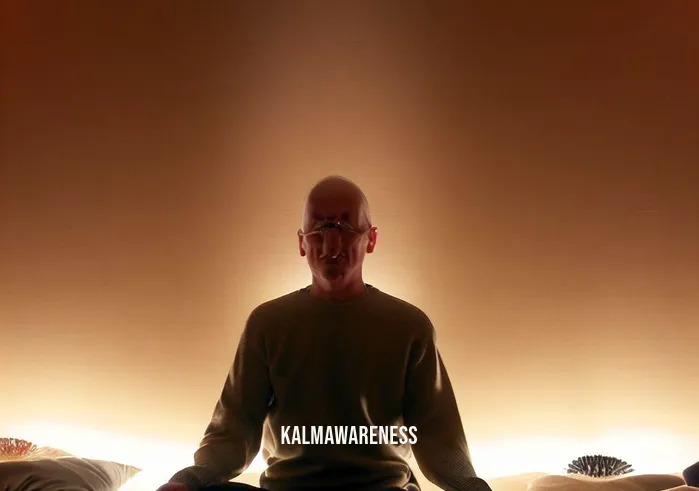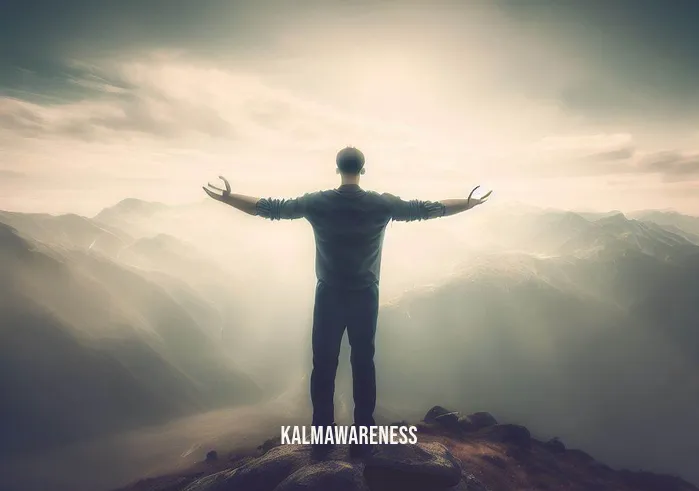The Liberating Power of Detachment Meditation
What is Detachment Meditation?
Detachment meditation is a form of practice that aims to cultivate a state of non-attachment, emotional freedom, and self-awareness. Unlike other methods, like comfort meditation, detachment meditation focuses not on making you feel better in the moment, but on freeing you from the habitual patterns that bind you to emotional suffering. This technique is beneficial for those who find themselves getting caught in cycles of emotional highs and lows. It allows for the cultivation of serenity and offers a fresh perspective on life.
Emotional Entanglements and Non-Attachment
The first step towards achieving emotional freedom is understanding your current emotional state. You may be surprised at what you discover about yourself. For instance, you can take this am I emotionally mature quiz to get an idea of where you stand. Emotional maturity often correlates with the ability to detach and look at situations objectively.
Non-attachment doesn’t mean not caring. It signifies a state of emotional equilibrium, where you neither cling to joy nor shun sorrow. You navigate through emotions like a boat in calm water, not getting stuck in the highs or lows, but observing them as they come. This philosophy is in line with the concept of practicing equanimity.
Quote: “Detachment is not about refusing to feel or not caring or turning away from those you love. Detachment is deeply connected to the work of compassion.”
Breathing and Detachment
Breathing is a key component in many meditation practices, including detachment meditation. Unlike floating meditation, which may involve complete sensory isolation, breathing in detachment meditation keeps you grounded in your senses. Focusing on the breath helps cultivate a space between your self and your reactions, a gap where you can observe without judgement.
The Role of Self-Awareness
Self-awareness is the cornerstone of detachment meditation. It’s not just about finding peace, as you might experience through calming ocean pictures or the sound of calming rain. True self-awareness involves an in-depth understanding of your emotions, habits, and thought patterns. This knowledge serves as your inner compass, guiding you through the labyrinth of your mind to a state of emotional liberation.
So, how do you foster self-awareness?
- Begin by acknowledging your current emotional state.
- Note any automatic negative thoughts you might be harboring.
- Identify triggers that elicit strong emotional responses.
- Use your breath to create a buffer between you and your emotional reactions.
How It Differs from Other Meditation Techniques
It’s easy to get confused with the myriad of meditation techniques available. Detachment meditation distinguishes itself through its emphasis on non-attachment. Other forms of meditation, such as desert meditation, may concentrate on a specific theme or setting. But detachment meditation is more aligned with the idea to relax and be aware, allowing emotions to rise and fall without getting caught in them.
Why Continue Exploring Detachment Meditation?
Detachment meditation offers more than momentary relief. It provides tools to deal with emotional turmoil at its root. You’ll learn ways to practice emotional freedom, cultivate serenity, and heighten your self-awareness. This practice can be a life-changer, influencing everything from how you perceive yourself when looking in the mirror to how you engage in mindful relationship habits.
Intrigued? Ready to discover the steps and techniques involved in detachment meditation? Continue reading in the next segment where we will delve deeper into the practical application of this enlightening method.

Navigating the Nuances of Detachment Meditation
The Multifaceted Benefits of Detachment Meditation
We have already introduced detachment meditation as a transformative practice for emotional freedom, serenity, and self-awareness. But how exactly does it compare to other meditative practices? When should you choose this method over other forms of mindfulness? The importance of detachment meditation can be emphasized by its unique blend of benefits, including the instillation of a calm demeanor, enhanced self-awareness, and the alleviation of emotional burdens. If you’ve ever found yourself looking in the mirror sadly, this practice can help you rediscover your inner joy and tranquility.
Emotional Freedom vs. Mindless Listening
While detachment meditation aims to cultivate emotional intelligence, other practices may not focus on this aspect. For example, some people resort to mindless listening as a way to escape their problems. This only offers temporary relief and often serves to sweep the underlying issues under the rug. Detachment meditation, on the other hand, helps you confront and understand your emotions, leading to true freedom.
The Techniques: What’s in the Toolkit?
Detachment meditation involves various techniques to help guide you toward a state of non-attachment. It’s not just about breathing or repeating a mantra; it’s a combination of various elements that help you explore your inner world.
Table: Techniques in Detachment Meditation
| Technique | Purpose | Related Practices |
|---|---|---|
| Focused Breathing | To anchor the mind | Breathing and Meditation |
| Mindfulness | To cultivate awareness | Relax and Be Aware |
| Emotional Labeling | To identify emotions | Is Curiosity a Feeling? |
| Self-Inquiry | To question thought patterns | The Ego |
| Loving-Kindness | To cultivate compassion | Blessing Love |
The Role of the Inner Compass and Angelic Guidance
As you journey through detachment meditation, it’s beneficial to have a navigational aid or what we might call an inner compass. This inner compass is your innate sense of what is true for you and what isn’t. It guides you through the murky waters of your thoughts, helping you maintain course towards emotional freedom. Some practitioners also turn to spiritual guides like Angel Muriel for additional support and inspiration.
Steps to Incorporate Detachment Meditation into Your Routine
Incorporating this practice into your daily life is simpler than you might think. Here are some steps to get started:
- Set Your Intention: Before you begin, know what you want to achieve. Are you looking to become more emotionally mature, or perhaps find more serenity in your life?
- Choose Your Setting: Unlike floating meditation, you don’t need a specific setting. You can practice detachment meditation wherever you feel comfortable.
- Select a Technique: Refer back to the table above to choose a technique that resonates with you.
- Time It Right: Decide the duration for your practice. Start small, perhaps five minutes, and increase gradually.
- Reflect and Adapt: After your session, take a moment to reflect. What worked? What didn’t? Adjust your technique accordingly for future sessions.
Learning to Sit with Emotions
One of the most crucial lessons that detachment meditation teaches is how to sit with emotions. This involves being fully present with whatever feelings arise, without judgment or the need to act on them. It’s a vital skill for emotional intelligence and overall well-being.
What’s Next?
If you’ve made it this far, you’re probably keen to learn more. Detachment meditation is a powerful tool for personal growth, and its applications go beyond mere emotional freedom to touch upon relationship dynamics and even your everyday choices.
In the next chapter, we will explore some advanced techniques in detachment meditation that can propel you to new heights of self-discovery and emotional well-being. We’ll dig deeper into the practice’s applications in relationships, and how it can be an instrumental part of your toolkit for living a fulfilled life. Ready to discover more? Continue reading to unlock the deeper layers of this enlightening method.

The Well of Hope: Detachment Meditation as a Source of Inspiration
The Inspirational Power of Detachment Meditation
Detachment meditation is far more than just a tool for emotional tranquility or self-awareness. It also serves as a profound source of inspiration and hope. The practice brings clarity to the mind, allowing us to recognize and seize upon life’s opportunities. Those who’ve practiced calming meditation know the peace it can bring, but detachment meditation goes a step further. It not only calms the storm but also lets you find the rainbow that follows.
“The quieter you become, the more you can hear.”
– Ram Dass
Finding Light in Life’s Mirrors
The ancient wisdom that “life is like a mirror” holds true in many ways. When you practice detachment meditation, you realize that your external experiences often reflect your inner state. This gives you a unique vantage point to approach challenges and situations with hope, reframing them as opportunities for growth and enlightenment.
“Your vision will become clear only when you can look into your own heart. Who looks outside, dreams; who looks inside, awakes.”
– Carl Jung
Turning Automatic Negative Thoughts into Hope
One of the hindrances people face while trying to find inspiration is the presence of automatic negative thoughts. These thoughts can be silenced, or better yet, transformed through detachment meditation. When you learn to sit with your emotions and thoughts, you open the door to turning your challenges into sources of hope and inspiration.
Attuning to Equanimity and Serenity
Practicing detachment meditation enables you to find a state of equanimity. This level-headedness or even-mindedness allows you to navigate life’s ups and downs with grace. There is immense hope to be found in this tranquility, which further amplifies the meditative experience.
“Serenity comes when you trade expectations for acceptance.”
– Unknown
Sailing Through Life’s Storms with Calming Imagery
Visualization is another powerful component of detachment meditation. Immersing yourself in calming ocean pictures or imagining the soothing drops of calming rain can enrich your meditative experience. These techniques not only enhance relaxation but also inspire hope by providing a tranquil backdrop against which to evaluate life’s challenges.
Building Mindful Relationships Through Inspiration
Being inspired doesn’t mean going it alone; quite the opposite. One often-overlooked application of detachment meditation is in the arena of mindful relationship habits. When you are a source of inspiration and hope to yourself, you naturally become the same for others. The practice teaches you the fine art of being present, empathetic, and emotionally intelligent, making your interpersonal relationships as enriching as they are enduring.
“In the end, only three things matter: how much you loved, how gently you lived, and how gracefully you let go of things not meant for you.”
– Buddha
What Awaits You in the Journey Ahead?
We have explored how detachment meditation serves as a wellspring of hope and inspiration, enriching not just our personal but also our relational well-being. Yet, the journey is far from over. The ripples of detachment meditation touch not just the mind and soul but also have profound implications for our physical health.
In the next chapter, we delve into the compelling science behind detachment meditation, offering insights into how this age-old practice can have modern-day benefits for your physical health. Intrigued? Continue reading to further uncover the intricate tapestry of well-being that detachment meditation weaves.

The Anatomy of Detachment: A Closer Look at Detachment Meditation
A Smoother Path with Detachment Meditation
Detachment meditation offers a smoother path towards serenity, emotional freedom, and self-awareness. While similar practices like floating meditation might capture your interest, the core strength of detachment meditation lies in its ability to facilitate a profound internal journey. With this practice, you engage your inner compass to navigate the complexities of emotional and mental landscapes.
Why Detachment Meditation Over Other Forms
- Accessibility: Unlike practices requiring special environments, detachment meditation can be done anywhere.
- Emotional Freedom: It teaches non-attachment, helping you find freedom from compulsive emotional reactions.
- Broad Application: It can be applied to diverse life scenarios, from personal challenges to mindful relationship habits.
Unlocking the Mind’s Potential
Detachment meditation can be likened to peeling an onion; each layer represents a different aspect of your consciousness. When you focus intently and mindfully, you can delve deeper into the recesses of your own mind, challenging your own automatic negative thoughts and making room for more productive and constructive thinking.
Key Areas of Impact
- Self-awareness: Develops an understanding of your own thought patterns and behaviors.
- Non-attachment: Teaches you the art of letting go, often misconstrued as indifference or apathy.
- Emotional Stability: Bolsters your emotional resilience, making you less susceptible to sudden emotional fluctuations.
The Risks of Mindless Listening
“To listen is to lean in softly, with a willingness to be changed by what we hear.”
- Mark Nepo
In contrast to the powerful, focused listening during detachment meditation, it’s worth noting what happens when we practice mindless listening. This form of passive, unfocused listening can undermine emotional freedom, stifle self-awareness, and obstruct serenity. Detachment meditation helps train your mind to focus and absorb, enhancing your cognitive and emotional faculties.
Detachment Meditation vs Other Practices
Here’s a table comparing detachment meditation with other popular forms:
| Meditation Type | Focus Area | Time Needed | Emotional Benefits |
|---|---|---|---|
| Detachment Meditation | Self-awareness, Non-attachment | 10-30 min | High |
| Comfort Meditation | Physical Relaxation | 10-20 min | Moderate |
| Floating Meditation | Sensory Experience | 60 min | Moderate |
| Desert Meditation | Mental Clarity | 20-40 min | Moderate to High |
| Breathing and Meditation | Breathing Techniques | 5-15 min | Low to Moderate |
What Lies Beyond the Horizon?
We’ve dissected the core components of detachment meditation, from its ability to enhance self-awareness to its potential risks when not practiced mindfully. As we prepare to conclude our exploration, the final chapter promises to tie together these diverse strands into a comprehensive overview. Expect to encounter holistic approaches and endearing stories that showcase the transformative power of detachment meditation. Intrigued? Your journey towards mastering detachment meditation is just a chapter away. Continue reading to complete your understanding of this life-changing practice.

The Reflective Pond: Wrapping up Our Exploration on Detachment Meditation
A Sigh of Emotional Freedom
As we come to the close of our enlightening journey through detachment meditation, it’s much like approaching the calming shore after a rigorous swim in a sea of emotions and thoughts. When you learn to relax and be aware, you gift yourself the serenity you’ve been seeking. You’re essentially reciting a blessing of love to your own soul, affirming that it’s OK to be present without being consumed by emotions or situations.
Gaining an Edge in Self-Awareness
The practice of detachment meditation serves as a crucial element in elevating your self-awareness. As you might have learned through our emotionally mature quiz, understanding your own emotional reactions is a cornerstone for mature interactions and personal growth. It is essentially tapping into your inner compass in a more acute way. It’s the ingredient that enhances emotional freedom, adds tranquility to your life, and turns you into a more self-aware individual.
Life’s Mirror: What Did We See?
“Life is like a mirror, we get the best results when we smile.”
In the grand scope of things, life is like a mirror, reflecting back what we put in. Detachment meditation teaches us to approach life not as a battle to be won or lost, but as an experience to be understood and appreciated. Whether you are sitting with emotions or practicing equanimity, your calm demeanor is now a beacon of light guiding you through life’s complexities.
Ocean of Calm or a Stormy Sea?
Do you remember those calming ocean pictures that evoke an instant sense of peace? That’s what your internal landscape can resemble when you immerse yourself in detachment meditation. On the other hand, neglecting this practice could leave you more akin to a turbulent sea, clouded by an ego that can’t distinguish between the self and external stimuli.
Your Journey Has Just Begun
Although we’re wrapping up this particular chapter on detachment meditation, understand that your journey has just begun. Revisit previous chapters if you need more clarity or want to reinforce your practice. Maybe even explore the array of other enriching content that we offer.
Final Gratitude
Thank you for dedicating your time and attention to this enriching exploration of detachment meditation. We promise more groundbreaking content in our future editions to guide you towards emotional freedom, serenity, and self-awareness.
What’s Next?
Eager to dive deeper into the world of mindful practices? Consider this an invitation to continue your journey with us. There’s a sea of wisdom waiting for you in other articles and discussions, each more enlightening than the last. So take the plunge. Your future self will thank you.





